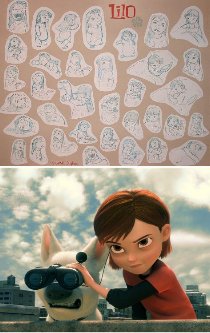Rhett Wickham: The Art of Bolt Review
Page 1 of 3

Click here for a much larger version of this picture
A colleague recently wrote in a letter, �Bolt is very, very good. It�s a lot of fun and hopefully will do well at the box office. (I) really enjoyed it.�
So I have it on good authority from many folks that �Bolt� is a solid and satisfying film. I have no reason to think otherwise, based on previous recommendations from the same folks, and the writing and story track record of Co-Directors Chris Williams and Byron Howard. Similarly, I believe it will please CG skeptics and critics of Disney post Pixar absorption (as to whom was absorbed by whom, I�ll let you decide.) Taken at face value, the film is more than likely going to perform beyond expectations when it arrives in theatres on November 21.
But �art of� and �making of� books aren�t about the destination, they�re about the journey. The fun of them is the insight they offer into process, not product, and the thrill they afford aficionados and geeks as well as laypeople and coffee-table artifact hunters. Here, so the promise goes, you will find a storehouse of behind-the-scenes treasures, a peek at the DNA of Disney characters.
If you leaf through the handsome and colorful The Art of BOLT, by Mark Cotta Vaz that hit shelves this past week at an equally handsome $40 from Chronicle Books, you will see some appealing and smart designs from the likes of Joe Moshier, Byron Howard and Chen-Yi Chang, among others, many rendered in marker or graphite. The pages are filled with various incarnations of the title character and his pals Mittens and Rhino that hearken back to the genius of Ward Kimball and Tom Oreb and make the reader ever-hopeful that some of this magic made its way onto the screen. These are distinct, fun, funny and soon-to-be ubiquitous Disney brands that quite likely have a long, long life ahead of them. The only exception being the horribly generic Penny, who lacks any of the charming specificity and distinct personality of �The Rescuers� heroine of the same name, and whose design is even more unimaginative and dull than that of �Oliver & Co.�s Jenny (�if such animated homogenization is even possible ) and this is a terrible shame considering what a great leap into imperfect charm was made with the last Disney child heroine, Lilo.

Click here for a much larger version of this picture
The driving premise of the book is that this is the first feature fully under Lasseter�s watch, and as such, a new aesthetic and higher standard has been brought to bear on the production. The book asks us to believe that with the merger of Pixar came an approach to film making that rid the Disney studio of single-minded auteurs, replacing them with a �brain trust� of collaborative course-correcting colleagues.
Lasseter in particular viewed Bolt as a chance to reconnect the studio�s creative and artistic heritage, and was adamant that the painterly design not distract from �believability,� which became one of the many mantras that informed Bolt. In the process, Bolt reconnected with the Disney tradition of using life studies and research to inform the environments and characters the production conjured.
Hmmm. �Bout time, since nothing like that has been visible since�well, since�oh, wow, as far back as �Home on the Range.�
